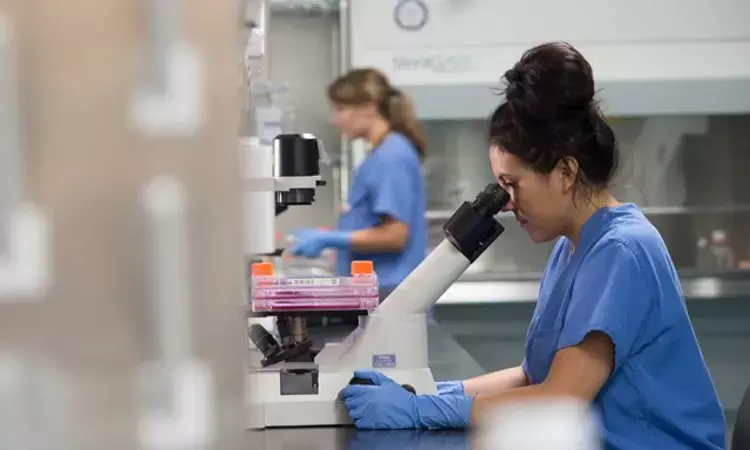- Home
- Medical news & Guidelines
- Anesthesiology
- Cardiology and CTVS
- Critical Care
- Dentistry
- Dermatology
- Diabetes and Endocrinology
- ENT
- Gastroenterology
- Medicine
- Nephrology
- Neurology
- Obstretics-Gynaecology
- Oncology
- Ophthalmology
- Orthopaedics
- Pediatrics-Neonatology
- Psychiatry
- Pulmonology
- Radiology
- Surgery
- Urology
- Laboratory Medicine
- Diet
- Nursing
- Paramedical
- Physiotherapy
- Health news
- Fact Check
- Bone Health Fact Check
- Brain Health Fact Check
- Cancer Related Fact Check
- Child Care Fact Check
- Dental and oral health fact check
- Diabetes and metabolic health fact check
- Diet and Nutrition Fact Check
- Eye and ENT Care Fact Check
- Fitness fact check
- Gut health fact check
- Heart health fact check
- Kidney health fact check
- Medical education fact check
- Men's health fact check
- Respiratory fact check
- Skin and hair care fact check
- Vaccine and Immunization fact check
- Women's health fact check
- AYUSH
- State News
- Andaman and Nicobar Islands
- Andhra Pradesh
- Arunachal Pradesh
- Assam
- Bihar
- Chandigarh
- Chattisgarh
- Dadra and Nagar Haveli
- Daman and Diu
- Delhi
- Goa
- Gujarat
- Haryana
- Himachal Pradesh
- Jammu & Kashmir
- Jharkhand
- Karnataka
- Kerala
- Ladakh
- Lakshadweep
- Madhya Pradesh
- Maharashtra
- Manipur
- Meghalaya
- Mizoram
- Nagaland
- Odisha
- Puducherry
- Punjab
- Rajasthan
- Sikkim
- Tamil Nadu
- Telangana
- Tripura
- Uttar Pradesh
- Uttrakhand
- West Bengal
- Medical Education
- Industry
Scientists discover Novel Regenrative Treatment Path for Diabetic foot ulcer

Hippo signalling is an evolutionarily conserved pathway that restricts organ growth during development and suppresses regeneration in mature organs. In a recent study, researchers have discovered a novel molecule PY-60 that targets the ANXA2 protein. The researchers found by targeting ANXA2 protein, a druggable component of the Hippo pathway, the PY-60 drug were able to boost cell division and promote regenerative repair in chronic disease. The research has been published in the journal Nature Chemical Biology on March 15, 2021.
The transcriptional coactivator Yes-associated protein 1 (YAP) orchestrates a pro-proliferative transcriptional program that controls the fate of somatic stem cells and the regenerative responses of certain tissues. YAP is a major downstream effector of the Hippo intracellular signaling pathway, with key roles in organ development, regeneration, and cancer biology. A small molecule that targets Annexin (ANX) acts through YAP to promote rapid epidermal tissue expansion. Dr Michael J. Bollong and his team hypothesized that activation of YAP may hold therapeutic potential in disease states exacerbated by insufficient proliferative repair.
"We developed a way to activate multiple aspects of wound healing using a small-molecule drug that can be applied topically, without affecting other tissues," Bollong says. "Essentially, we were able to trick the cells into proliferating and closing the wound, restoring the outer layers of skin."
Bollong's group along with the laboratory of Scripps Research President and CEO Peter Schultz, PhD, and drug discovery teams at Calibr, screened more than 800,000 molecules to find one that stimulated key regenerative pathways.
They discovered the novel molecule PY-60, which robustly activates YAP transcriptional activity in vitro and promotes YAP-dependent expansion of epidermal keratinocytes in the mouse following topical drug administration.
Upon chemical proteomics, they found a relevant target of PY-60 to be annexin A2 (ANXA2), a protein that directly associates with YAP at the cell membrane in response to increased cell density.
Beyond treating chronic wounds, Bollong says the approach may lead to new regenerative therapies for heart disease, liver conditions and inflammatory bowel disease, or IBD. "We believe the future of this type of regenerative therapy is incredibly bright," Bollong says.
They found that treatment with PY-60 liberates ANXA2 from the membrane which ultimately promotes a phosphatase-bound, nonphosphorylated and transcriptionally active form of YAP.
The authors concluded, "This work reveals ANXA2 as a previously undescribed, druggable component of the Hippo pathway and suggests a mechanistic rationale to promote regenerative repair in disease."
"We found the results of the study to be incredibly compelling," Bollong added. "We hope this regenerative approach can eventually be added on to existing standards of care for diabetic foot ulcers."
For further information:
Medical Dialogues Bureau consists of a team of passionate medical/scientific writers, led by doctors and healthcare researchers. Our team efforts to bring you updated and timely news about the important happenings of the medical and healthcare sector. Our editorial team can be reached at editorial@medicaldialogues.in.
Dr Kamal Kant Kohli-MBBS, DTCD- a chest specialist with more than 30 years of practice and a flair for writing clinical articles, Dr Kamal Kant Kohli joined Medical Dialogues as a Chief Editor of Medical News. Besides writing articles, as an editor, he proofreads and verifies all the medical content published on Medical Dialogues including those coming from journals, studies,medical conferences,guidelines etc. Email: drkohli@medicaldialogues.in. Contact no. 011-43720751


